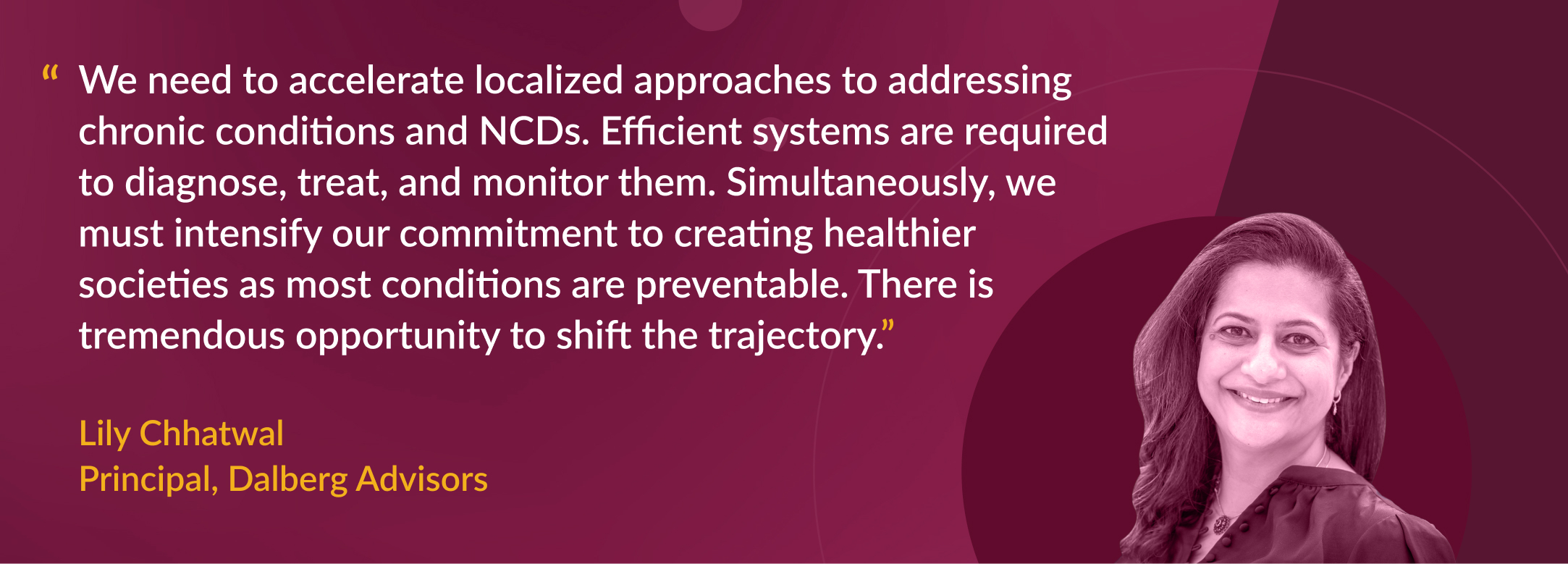Dalberg uses cookies and related technologies to improve the way the site functions. A cookie is a text file that is stored on your device. We use these text files for functionality such as to analyze our traffic or to personalize content. You can easily control how we use cookies on your device by adjusting the settings below, and you may also change those settings at any time by visiting our privacy policy page.
Informed by conversations with clients and partners, our Global Health Practice Co-Leads—Lily Chhatwal and Lillian Kidane—share their perspectives on 10 global health trends. At the crossroads of unparalleled medical advancements and intricate healthcare complexities, they highlight opportunities that extend beyond borders and are steeped in resilience, equity, and ingenuity.
1. Strengthening Health Systems
Reflecting on the lessons learned from the COVID-19 pandemic, there is a global need to strengthen health systems. Offering holistic care, providing access, and ensuring affordability continue to strain health systems. Additionally, health systems need to have the ability to respond to real-time and emerging threats efficiently and equitably. This includes preparing for changing disease patterns, weather events, and addressing potential future pandemics.
Recently, Dalberg has been collaborating with G7 leaders to outline a new development finance collaborative for equitable response to future health emergencies. This includes availability of financial liquidity on “day zero” of an emergency. Dalberg supported the U.S. International Development Finance Corporation (DFC) and U.S. Agency for International Development (USAID) to identify concrete options for development finance institutions (DFIs) to accelerate access to medical countermeasures in health emergencies.
Read more*
- A New Development Finance Institution Collaborative for Equitable Health Emergency Response
- How Digital Healthcare Payments can Drive Access and Affordability in Nigeria
- Seven Ways to Maximize the Potential of Health Investments Through Better Impact Measurement
2. Healthcare Worker Shortage
A looming shortage of 10 million health workers by 2030 poses a significant challenge, with 89% of the shortage concentrated in low- and middle-income countries. The primary factor contributing to a shortage: resource constraints in educating health professionals. Training can be expensive and time consuming. Doctors and nurses pursue better employment opportunities overseas, which further increases gaps in care in their home countries.
Meanwhile, worker frustration is evidenced by a rising number of worker strikes, specifically in Europe and the U.S. Understaffing and shortages are leading to burnout, with many either experiencing low levels of job satisfaction or quitting the profession. To retain and boost the number of healthcare workers, we need to increase pathways to affordable education, provide sufficient resources, ensure health workers have decision-making seats, and offer competitive wages and working conditions.
Read more
Funding Equity in Health Workforce Development
3. The Rise of Noncommunicable Diseases (NCDs)
The rapid rise of NCDs such as cardiovascular diseases, cancers, obesity, diabetes, and mental health conditions are the leading cause of death globally, killing 41 million people each year and representing 74% of all annual deaths, as estimated by the WHO in 2023. One global study predicts that more than half the world’s population will be overweight or obese within 12 years if prevention, treatment, and support do not accelerate. Meanwhile, mental health conditions alone account for one in six years lived with disability.

Read more
Five Insights Towards Supporting Youth Aspirations for their Mental Health
4. Climate Change and Implications for Human Health
From extreme weather events disrupting food systems to global warming changing disease patterns, the intersectionality of climate and health is vast. The Intergovernmental Panel on Climate Change (IPCC) research shows that ~3.6 billion people already live in situations that are vulnerable to climate change. Additionally, heat-related deaths of people older than 65 have increased by 85% from 1990–2000.
The Lancet Countdown on Health and Climate Change 2023 indicates that global investment in clean energy is moving in the right direction, far exceeding investment in fossil fuels. Increasingly, we have been working with clients on climate financing, promoting leadership intersectionality of health and climate, accelerating interventions such as disease surveillance and innovation in therapeutics and vaccine development.
Read more*
- Charting the Path to Global Preparedness: The Cost of Environmental Surveillance in LMICs
- Climate x Health Public Engagement Leadership Program
- Experts Call for Prioritization of Climate Change Mitigation Amid Emerging Threats
5. Artificial Intelligence (AI)
A total of 30% of the world’s data volume is generated by the healthcare industry, and AI presents an immense opportunity for innovation in clinical care (including aforementioned health system and workforce strengthening), bolstering health research and drug development, and supporting public health interventions.
To make this vision a reality, AI solutions must be firmly rooted in ethical and equity considerations. They must be democratized and made accessible to the masses, ensuring that advancements benefit all individuals and solutions are inclusive. Rapid innovation and the emergence of new use cases underscore the need to adhere to a set of guidelines for the responsible employment of AI in healthcare, emphasizing accountability, equity, transparency, and prioritization of public health interests as fundamental tenets.
Read more
How Investing Strategically in Health Data Can Transform Healthcare Delivery
6. Women’s Health
Over the course of their lifetimes, women spend 25% more time in “poor health” relative to men. This disparity is gaining increased attention and investment. Closing the gender health gap could add at least $1 trillion a year to the global economy by 2040, according to a recent report published by the World Economic Forum and McKinsey Health Institute.
Coming out of the World Economic Forum, the recently launched Global Alliance for Women’s Health, a multisector global platform to improve investment in women’s health, is a step forward. Additionally, the Biden Administration’s first-ever Initiative on Women’s Health Research is a crucial measure, positioned to address health disparities and bolster investments in areas such as heart attacks in women and menopause. The Initiative is a timely opportunity for fresh collaborations between the public and private sectors and philanthropic organizations to drive transformation through innovations in women’s health.
Read more*
- How to Accelerate Digital Innovations for Women’s Reproductive Health
- Dalberg at Women Deliver
- Discovering IV Iron’s Untapped Market in LMICs, Drip by Drip
7. Health Equity
The persisting inequitable access to quality health services is rooted in disparities. It impacts the livelihood of communities and exacerbates pressure on economic growth. Health inequities cost an estimated $1 billion across the European Union and $450 billion in the U.S. annually. Ill health and premature mortality cost the African continent nearly $3 trillion in 2015.
While we have seen several initiatives on the local and global scale, continuous efforts are required. Dalberg recently supported the New York City Economic Development Corporation (EDC) and the Department of Health and Mental Hygiene (DOHMH) in developing a Pandemic Response Institute to respond to health emergencies in New York City with a focus on addressing disparities in racial and health equity. The NYC Pandemic Response Institute has been launched and housed in Columbia University.
Read more*
- How to Accelerate Digital Innovations for Women’s Reproductive and Sexual Health
- Designing Health Equity
- After the Vaccines Arrive: Equitable Vaccination in Lower-Income Countries
8. Domestic Manufacturing and Diversification of Supply Chains
Access to medical products remains a challenge in developing countries, requiring a balance between the availability of quality, affordable medical products and addressing public health priorities. Local production is one of the most viable solutions to reach this balance—a sector that is growing and diversifying in developing countries.
In Africa, for instance, organizations such as the African Union Commission, AUDA-NEPAD, and the Africa CDC have been pivotal in advancing the health products manufacturing sector. Initiatives like the Partnerships for African Vaccine Manufacturing (PAVM) and progress towards the African Medicines Agency (AMA) reflect concerted efforts to enhance Africa’s self-reliance in the health sector. Since existing initiatives largely cover tuberculosis, malaria, HIV, and AIDS, there is a growing need to expand to noncommunicable and neglected tropical diseases. Even as domestic manufacturing picks up in developing countries, international health stakeholders can play a leading role in building collaborations between national governments, local manufacturers, and global industry.

Read more*
Galvanizing Regional Partnerships for Sustainable Local Production and Equitable Access
9. Elderly Care
The global demographic shift towards an aging population, marked by over one billion people aged 60 and above, necessitates further approaches to addressing the distinct health of the elderly. In 2024, in Europe, individuals above 65 years of age are projected to outnumber those under the age of 15. The healthcare industry continues to adapt in providing comprehensive and personalized care, fostering a trend towards more inclusive and responsive elderly care models.
The UN Decade of Healthy Ageing (2021–2030) seeks to reduce health inequities and improve the lives of older people, their families, and communities through collective action in four areas:
- Changing how we think, feel, and act towards age and ageism
- Developing communities in ways that foster the abilities of older people
- Delivering person-centered integrated care and primary health services responsive to older people
- Providing older people who need it with access to quality long-term care. This would include building a wider network of comprehensive, affordable, community-based care and making strategic investments in health to prioritize high-quality care for the elderly and additional support for the chronically ill.
Read more*
10. Well-being
There is a growing focus from governments and private sector actors on improving lifestyles and optimizing health. The global wellness industry stood at $5.6 trillion in 2022 and is expected to grow another 52% by 2027, which will nearly double its 2020 size, estimates the Global Wellness Institute. Numerous governments worldwide are focusing on improving health and wellness among the population by providing guidelines and encouraging healthy lifestyle habits. In our recent work, we have analyzed “How valuable is physical activity to the economy?” If every adult in India were to shun a sedentary lifestyle by 2047, the annual GDP stands to gain $50 billion.
Read more
India’s GDP Could Grow by $50 Billion a Year through More Physical Activity
Get in Touch with our Global Health & Nutrition Practice Co-Leaders
Lillian Kidane
Partner & Regional Director for Africa
lillian.kidane@dalberg.com | Connect on LinkedIn
 Lily Chhatwal
Lily Chhatwal
Principal
lily.chhatwal@dalberg.com | Connect on LinkedIn
* Titles adjusted for AP style


